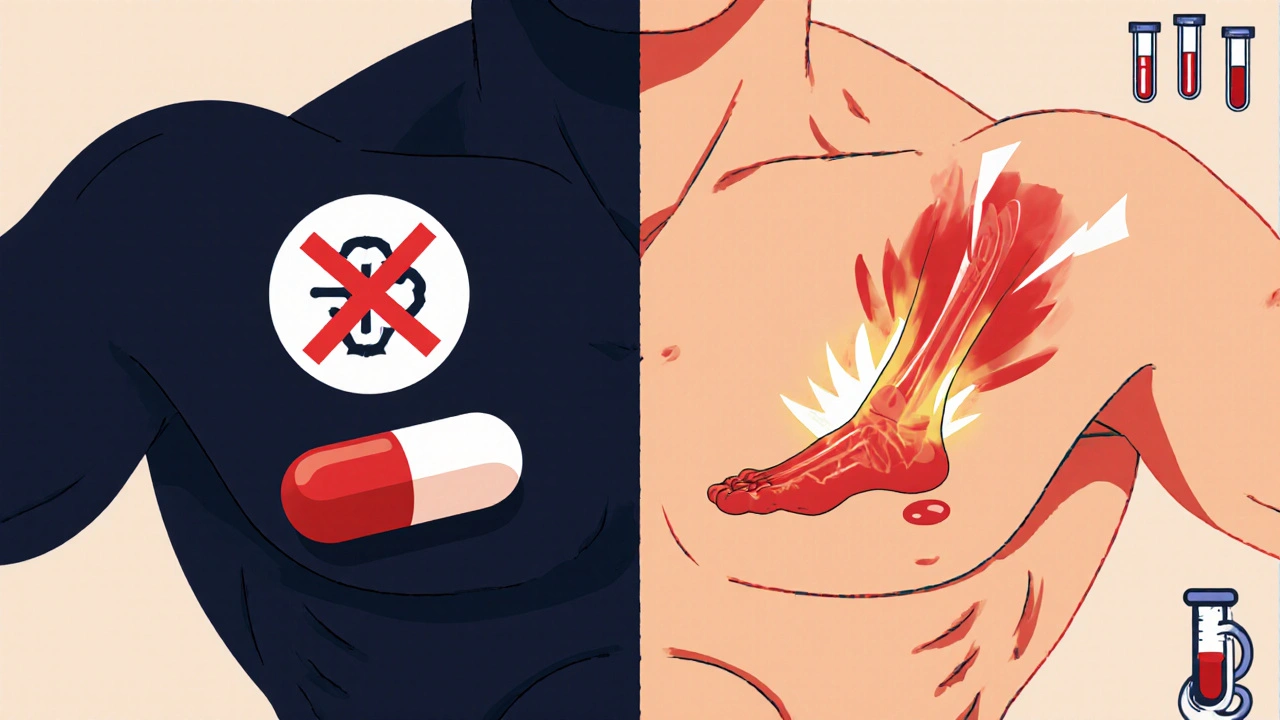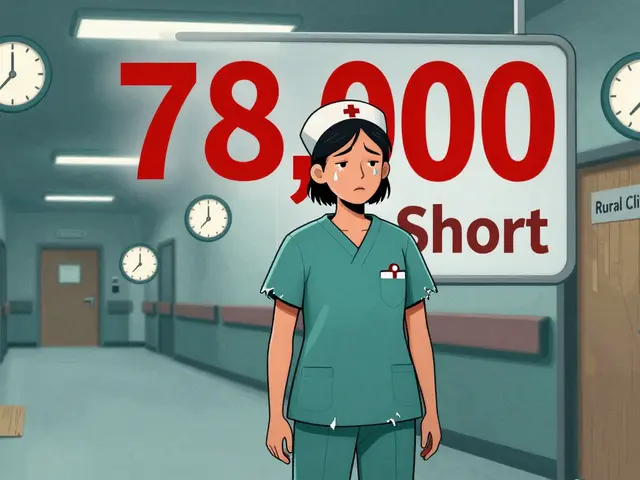
Bempedoic Acid Side Effect Risk Checker
Personal Risk Assessment
This tool assesses your risk of gout and tendon issues based on key medical factors from the article. Results are estimates only and should not replace professional medical advice.
Risk Results
When you can’t take statins because of muscle pain or weakness, bempedoic acid (sold as Nexletol) looks like a lifeline. It lowers LDL cholesterol without hitting your muscles the same way statins do. But here’s the catch: it doesn’t come without its own set of risks. If you’re considering this drug, you need to know about the real dangers - especially gout and tendon injuries - before you start taking it.
How Bempedoic Acid Works (And Why It’s Different From Statins)
Bempedoic acid works in the liver to block a different step in cholesterol production than statins. While statins inhibit HMG-CoA reductase, bempedoic acid targets ATP-citrate lyase. This means it doesn’t enter muscle tissue the same way, which is why muscle pain is far less common. For people who’ve had to quit statins because of cramps, weakness, or rhabdomyolysis, this is a big deal.
It’s not a miracle drug, though. It lowers LDL by about 17-22%, which is solid but not as strong as high-dose statins. That’s why it’s usually prescribed for people who can’t tolerate statins or need extra help lowering cholesterol even after taking them. It’s also sold as Nexlizet - a combo pill with ezetimibe - for patients needing more aggressive treatment.
The Most Common Side Effects You’ll Actually Feel
Most people tolerate bempedoic acid okay, but side effects are real and noticeable. In clinical trials, about 1 in 20 people reported:
- Muscle spasms (5.8%)
- Back pain (4.9%)
- Pain in hands or feet (3.4%)
- Upper respiratory infections (7.7%)
- Bronchitis (3.5%)
These aren’t rare. If you start taking it and suddenly feel like you’re always catching colds, or your lower back aches more than usual, it could be the drug. Most of these symptoms fade after a few weeks, but if they don’t, talk to your doctor. About 1.2% of people stopped taking it because of discomfort - not because it was dangerous, but because it made daily life harder.
Gout: The Hidden Risk Nobody Talks About
This is where things get serious. Bempedoic acid raises uric acid levels in your blood - by about 2.1% compared to placebo. That might sound small, but it’s enough to trigger gout attacks in people who never had them before.
In trials, 1.5% of people taking bempedoic acid had a gout flare. That’s three times higher than placebo. For those who already had gout, the risk jumped to 2.3%. If you’ve ever had a swollen, red, burning big toe - especially at night - you know how painful this is. And it can happen fast: most gout flares started within the first four weeks of treatment.
Doctors now recommend checking your uric acid levels before starting bempedoic acid and again at four weeks. If your levels are high, you may be put on allopurinol - a cheap, old drug that prevents gout. Studies show this cuts gout risk by 65%. If you’ve had gout before, this isn’t optional. Skip it, and you’re gambling with intense pain and possible joint damage.

Tendon Rupture: A Silent, Serious Danger
Here’s the side effect that scares cardiologists the most: tendon injuries. In clinical trials, 0.7% of people on bempedoic acid had tendon problems - including ruptures. That’s seven times higher than placebo. And it’s not just about the Achilles tendon. Shoulder, biceps, and rotator cuff tendons are also at risk.
What makes this dangerous is how sudden it is. People report hearing a “snap” or “pop,” then immediate pain and swelling. Some can’t walk. Others can’t lift their arm. It doesn’t always happen during exercise - sometimes it just happens while walking or standing.
The risk skyrockets if you’re taking bempedoic acid with a statin. One study found tendon rupture risk was 3.5 times higher when both drugs were used together. That’s why the European Atherosclerosis Society says: don’t use bempedoic acid if you’re already on fluoroquinolone antibiotics (like ciprofloxacin), have a history of tendon tears, or are older than 60. Those are red flags.
What About Liver and Blood Issues?
Some people get mild liver enzyme elevations - ALT or AST levels above normal. That happened in 2.2% of users, compared to 0.9% on placebo. In 1.6% of cases, levels went above three times the upper limit. Your doctor should check your liver function at the start and again after 4-8 weeks. If it keeps rising, they’ll likely stop the drug.
Anemia is another lesser-known side effect. Hemoglobin levels dropped slightly in about 1.8% of patients. But here’s the good news: most of these drops were mild - under 1 g/dL - and didn’t require stopping the medication. Still, if you’re feeling unusually tired, dizzy, or short of breath, get your blood checked.

Who Should Avoid Bempedoic Acid Altogether?
It’s not for everyone. Avoid it if:
- You’ve had a tendon rupture before
- You’re taking fluoroquinolone antibiotics (cipro, levaquin, etc.)
- You have active gout or very high uric acid levels (unless you’re on allopurinol)
- You have severe liver disease
- You’re pregnant or breastfeeding
The American Heart Association says this drug should only be used for people who truly can’t take statins. If you’ve tried two or three statins and had muscle pain every time, then yes - this might be your best option. But if you just didn’t like the idea of taking a daily pill, or you had mild muscle soreness that went away after a week, you might not need it.
What to Do If You’re Already Taking It
If you’re on bempedoic acid right now, here’s your action plan:
- Check your uric acid level - if you haven’t had it tested since you started, ask your doctor for a blood test.
- Watch for sudden joint pain, especially in your big toe. If it swells and turns red, stop the drug and call your doctor.
- Pay attention to any tendon pain, especially in heels, shoulders, or wrists. If you hear a pop or can’t move a joint normally, go to urgent care immediately.
- Don’t take fluoroquinolone antibiotics while on this drug. If you need an antibiotic, tell your provider you’re on Nexletol.
- Keep your liver function tests on schedule. Most doctors check at 4 weeks and then every 3 months.
Most people who take bempedoic acid do fine. But the side effects aren’t theoretical. They happen. And they can change your life in seconds - like a ruptured tendon or a gout attack that leaves you bedridden for days.
Is It Worth It?
The CLEAR Outcomes trial showed bempedoic acid reduces heart attacks, strokes, and heart-related deaths by 13% in high-risk patients. That’s meaningful. For someone with a history of heart disease who can’t take statins, that benefit might outweigh the risks.
But if you’re just borderline high cholesterol and your doctor is pushing it because “it’s new,” think again. You don’t need it. Lifestyle changes - diet, walking, weight loss - still work better than most pills for mild cases. And if you can tolerate even a low-dose statin, stick with it. Statins have 40 years of safety data. Bempedoic acid has five.
Bottom line: bempedoic acid is a tool - not a first-line fix. Use it only when necessary, monitor closely, and don’t ignore the warning signs. Your tendons and joints will thank you.
Can bempedoic acid cause gout even if I’ve never had it before?
Yes. About 1.5% of people who’ve never had gout develop it while taking bempedoic acid. The drug raises uric acid levels in the blood, which can form crystals in joints - especially the big toe - triggering sudden, painful flares. This usually happens within the first month of treatment.
How common is tendon rupture with bempedoic acid?
Tendon rupture occurs in about 0.7% of users - seven times higher than placebo. The risk jumps to 1.8% if you’re also taking a statin. Most cases involve the Achilles tendon, but shoulders and wrists are also affected. Symptoms include a popping sound, sudden pain, swelling, and inability to move the joint.
Should I take allopurinol with bempedoic acid to prevent gout?
If your uric acid level is high or you have a history of gout, yes. Taking allopurinol (100-300 mg daily) reduces gout risk by about 65%. Your doctor should check your uric acid before starting bempedoic acid and again after four weeks. If it’s above 7 mg/dL, allopurinol is strongly recommended.
Can I take bempedoic acid with statins?
You can, but it increases the risk of tendon injuries by 3.5 times compared to taking bempedoic acid alone. The combo pill Nexlizet (bempedoic acid + ezetimibe) is safer for tendon risk than combining bempedoic acid with a statin. If you’re on both, watch for tendon pain and avoid fluoroquinolone antibiotics.
How long do side effects like muscle spasms last?
Muscle spasms and back pain often improve within 2-4 weeks of continuing the drug. Only about 1.2% of people stop taking it because of these symptoms. If they get worse or don’t fade after a month, talk to your doctor - it could be something else.
Is bempedoic acid safer than statins overall?
It’s safer for muscles - muscle side effects are about half as common as with statins. But it carries higher risks of gout and tendon rupture. Statins have decades of safety data. Bempedoic acid has five years. Choose it only if you truly can’t take statins, and only with close monitoring.
Are there any long-term side effects of bempedoic acid?
Long-term data beyond five years is still limited. So far, no new major risks have emerged, but ongoing studies are watching for chronic tendon damage, kidney issues from repeated gout, and liver changes. For now, the known risks - gout, tendon injury, liver enzyme spikes - are the main concerns.






19 Comments
Just started this drug last week and my big toe is already throbbing. Guess I’m the 1.5%.
It is imperative that patients be informed of the elevated risk of gout and tendon rupture associated with bempedoic acid. Clinical trial data, while robust, must be contextualized with individual patient histories. Prophylactic allopurinol should be considered in all high-risk populations prior to initiation.
Everyone’s acting like this is some new deadly drug. Statins kill more people with rhabdo every year than bempedoic acid has in five. If you’re too lazy to diet and exercise, then sure, blame the pill. But don’t act like you’re being experimented on - you’re just trading one set of risks for another. Get real.
For those who don’t know, the ATP-citrate lyase inhibition pathway is actually upstream of HMG-CoA reductase - which is why it doesn’t affect muscle tissue. But that same mechanism increases purine synthesis, hence the uric acid spike. It’s not a bug, it’s biochemistry. If your doc didn’t explain this, they’re cutting corners.
Also, the tendon risk? It’s not just statin combo. The drug alters collagen cross-linking in tendons. Animal studies showed this at 3 months. We’re just now seeing it in humans. If you’re over 50 and lifting weights, you’re playing Russian roulette.
I’ve been on this for 8 months. My cholesterol dropped 20%. My gout? Three flares. My Achilles? A dull ache that never goes away. I used to run 5Ks. Now I walk. I’m not mad. I’m just… sad. This drug didn’t save me - it just traded one prison for another. I thought I was choosing health. Turns out I chose slow erosion. I wish someone had told me it wasn’t just about LDL numbers. It’s about your body’s quiet rebellion.
I’m not saying don’t take it. I’m saying: if you do, pay attention to the whispers before they become screams.
It’s funny how we treat drugs like they’re magic wands. You want lower cholesterol? Fine. But you’re not just lowering a number - you’re messing with a 4-billion-year-old system. Evolution didn’t design us to suppress cholesterol with synthetic molecules. We’re tinkering with a system we barely understand.
Statins? They’re blunt instruments. Bempedoic acid? A scalpel with a hidden blade. Both work. Both break things. The question isn’t ‘which is safer?’ - it’s ‘what are you willing to lose?’
Maybe the real problem isn’t the drug. Maybe it’s that we’ve turned our bodies into balance sheets. LDL down? Good. Tendon gone? Oh well. We’re not treating patients. We’re optimizing metrics.
Oh wow, so now we’re giving people a drug that gives them gout and breaks their tendons… and calling it ‘progress’? 😂
Let me guess - the pharma execs got bonuses for this one. ‘Hey guys, we found a way to make people who hate statins… hate something else too!’
Next up: a pill that lowers your cholesterol but gives you spontaneous salsa dancing urges. Because why not?
Thank you for sharing this detailed information. In India, many patients are unaware of such side effects. We often rely on doctors without asking enough questions. I hope more people read this and discuss with their physicians before starting any new medication. Health is not just about numbers - it is about living well.
Man, I read this and thought: ‘This is why I stick to olive oil, walking, and not eating donuts.’ No pill replaces a life well-lived. I’ve seen too many people chase lab results while ignoring their actual bodies. Bempedoic acid might be a tool - but it’s not a replacement for common sense.
My mom’s on this. She’s 72. She’s had two gout flares. Her doctor said ‘it’s just coincidence.’ I asked for her uric acid levels - they were 9.2. No allopurinol. No warning. Now I’m scared. Please, if you’re taking this - get tested. Don’t wait for your toe to turn purple.
Just a quick heads-up: if you’re on bempedoic acid and get prescribed cipro for a UTI - say no. Don’t argue. Just say ‘I’m on Nexletol.’ Tendon rupture risk skyrockets. I’ve seen it twice. Both times, people were in their 60s. One needed surgery. The other? Never walked the same again.
I’ve been taking this for 6 months. My LDL dropped from 180 to 110. I’ve had zero gout. My tendons feel fine. I take allopurinol prophylactically and get liver tests every 3 months. It’s not scary if you’re proactive. This isn’t a horror story - it’s a responsibility story.
Did you know the FDA approved this based on a 3-year trial where 87% of participants were white? And the tendon rupture data? Only 12% of subjects were over 65. So they’re telling us it’s safe for seniors… but the data on seniors? Barely there. This isn’t medicine. It’s a gamble with your body. And they’re selling it like it’s a miracle.
Who benefits? Not you. Not me. The shareholders. They’re not worried about your Achilles. They’re worried about Q4 earnings.
So you’re telling me the solution to statin side effects is… a drug that gives you gout and snaps your tendons? Brilliant. I’m starting a support group: ‘I took the pill that saved my heart… and lost my ability to walk.’
OMG this is so important!! 💔😭 I’ve been on Nexletol since January and my toe literally exploded last week 😭 I thought it was a sprain… then my doctor said ‘gout.’ Now I’m on allopurinol and I feel like a science experiment 🤖💊 #BempedoicAcid #GoutSurvivor
If you’re reading this and thinking, ‘I don’t need to get tested,’ you’re wrong. Uric acid is silent until it’s not. Tendon damage is silent until it’s catastrophic. Prevention isn’t optional - it’s non-negotiable. Talk to your doctor. Get the labs. Take the allopurinol. You’re not being paranoid - you’re being responsible.
There is a quiet irony in our medical age: we have never had more power to manipulate biology, and yet we have never been less equipped to accept the cost. Bempedoic acid is not evil. It is merely a mirror - reflecting our desperation for control, our refusal to sit with uncertainty, our belief that every problem must be solved with a molecule.
Perhaps the real side effect is not gout or tendon rupture - but the erosion of trust in our own bodies, and the surrender of health to the algorithm of the pill.
Check uric acid before starting. Get liver tests at 4 weeks. Avoid fluoroquinolones. Take allopurinol if needed. Simple.
Wait - so this drug lowers LDL but increases uric acid? That’s not a side effect, that’s a feature. The pharmaceutical industry doesn’t want you healthy - they want you on meds forever. Gout? Perfect. Now you need allopurinol. Tendon rupture? Now you need PT, maybe surgery. They’re not selling a cure. They’re selling a subscription.